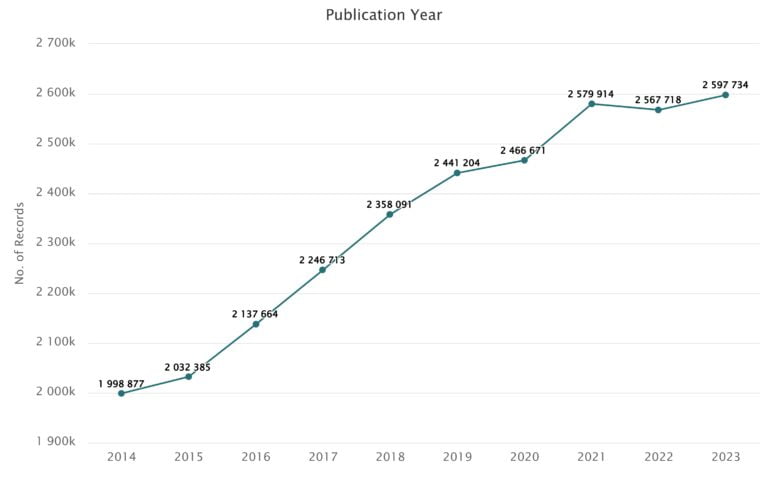
Share:
According to the World Intellectual Property Organization, investment in R&D is at an all-time high, with a global projection of USD 2.476 trillion in 2022. This increase in the quantity of patent applications in numerous industries has resulted in grant delays, further limiting innovation and discouraging R&D. According to a separate research conducted by the EPO, “a prior art search of around 1.3 billion technical records in 179 online patent databases led to about 600 million documents appearing in search results monthly.” Long wait times for patent inspections can deter enterprises from pursuing legal protection since by the time the patent is issued, the invention may be obsolete. AI, or Artificial Intelligence, has the ability to analyze large amounts of data in a short period of time based on a user’s specific demands, and patent-related data is no exception.
The integration of AI technology in patent offices is, in a way, transforming patent-related processes and increasing efficiency, timeliness, and sustainability.

Figure 1: Patent publications over last ten years
Let us look at how AI is reshaping the patenting process in Patent offices.
Improving application promptness and enhancing patent quality
AI-driven advancements in patent searches and examinations have revolutionized the speed and accuracy of these processes. By utilizing advanced AI search engines, patent examiners can swiftly analyze extensive patent data against new applications, resulting in more efficient searches. Additionally, machine learning models like LLMs enhance decision-making by comprehensively evaluating prior art and legal precedents. This not only improves the quality of patent examinations but also accelerates the overall process.
Helping control costs despite increasing patent examination workloads
AI algorithms are transforming the patent examination process by reducing the number of office actions, lowering expenses for inventors. These technologies easily examine patents and process huge amounts of data, saving time and resources. AI can uncover patterns and trends in patents using data analysis and prediction models, assisting patent offices in detecting probable instances of intellectual property infringement. This allows for improved decision-making, assuring the protection of inventors’ rights and the long-term viability of intellectual property.
Automating Patent Classification with AI
Accurate classification of patent applications is essential for directing them to the correct examination team. To simplify this process, an AI-powered prediction function can now determine the relevant International Patent Classification (IPC) or Cooperative Patent Classification (CPC) classes based on a paragraph describing the new patent application. This automated patent classification system can assist in classifying incoming patent applications before their publication, ensuring that they are assigned to the appropriate examination team. The predictions can also be integrated into an IP office’s in-house tool via an API, further automating and enhancing the classification process.
Enhancing Accuracy and Precision in Patent Searches
The combination of Expert Boolean searches and AI-powered searches on a single platform has elevated the accuracy and precision of patent search reports. By leveraging both types of searches, patent examiners can obtain a deeper understanding of the prior art landscape. Additionally, an AI recommendation engine helps optimize search strategies by analyzing the user’s search approach and suggesting relevant records that may have been missed. This collaborative integration of artificial intelligence and expert search methodologies bolsters the accuracy and effectiveness of patent research and examination.
Automating Quality Inspection of Patent Applications
Spotting potential issues and inconsistencies within patent application drafts is a crucial yet time-consuming task for patent examiners. However, an AI-powered tool has been designed to automate quality inspection processes, identifying problems such as incorrect numbering, incomplete descriptions, syntax errors, and more. By addressing these low- to medium-cognitive analysis tasks, the automated quality inspection tool allows examiners to allocate more time to higher-cognitive analysis, like evaluating the broadness of claims or the presence of ambiguity. As this fully functional tool continues to improve and integrate into existing patent search platforms, it promises to enhance the efficiency and accuracy of patent examination processes.
Conclusion
The integration of AI technology into patent search and examination processes has brought about significant improvements in speed, classification accuracy, precision, and automation of quality inspection tasks. These advancements have alleviated the workload on patent examiners and allowed them to focus on higher-level analysis tasks. With the increasing adoption of AI by patent offices and the recognition of its potential to optimize the examination process, the future of patent searches and examinations looks promising. This combination of data, technology, and human expertise will continue to drive innovation, facilitate intellectual property protection, and meet the high expectations of stakeholders in the evolving landscape of intellectual property rights.
PatSeer offers innovative AI based features that transform patent examination processes. The AI-enabled Patent search engine speeds up the searches and helps rapid retrieval of relevant prior arts. The AI prediction function speculates the related IPC (or CPC) classes directing them to the right examination team. PatSeer’s AI and expert Boolean search together increase accuracy and precision while the AI recommendation engine ensures that no relevant records are missed. In addition, the system’s AI module examines patent application drafts identifying inconsistencies and errors that require lower cognitive analysis. PatSeer AI revolutionizes patent examination workflows, making them more efficient, accurate and easier.






